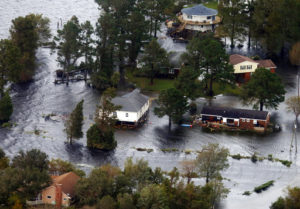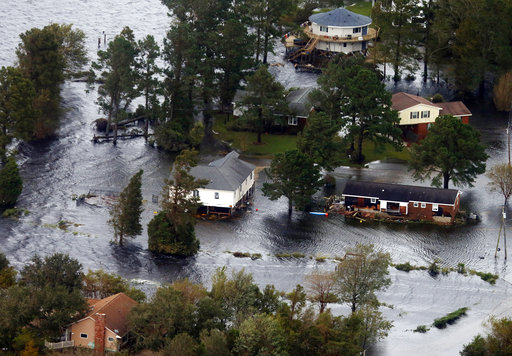Hurricane Michael’s devastation could spur policymakers to better prepare vulnerable communities for the effects of climate change.
The images of entire towns in Florida’s panhandle all but erased by storm surges, as well as accounts of bodies pulled from shattered homes, offer potent evidence of the need to rethink how and where Americans build homes, according to safety advocates, insurers and policy experts. They say that together with last year’s record storms and Hurricane Florence last month, the latest scenes of destruction could generate better laws and regulations around the country.
“Hurricane Michael’s devastating impact on Florida can only strengthen the urgent and profound case for better building code adoption and enforcement,” said Leslie Chapman-Henderson, president and chief executive of the Federal Alliance for Safe Homes, an advocacy group in Tallahassee.
A record 12 months of storms across the Atlantic and Gulf of Mexico has intensified the debate over climate adaptation: Whether, and how much, to tighten the rules that govern home construction in areas prone to flooding, hurricanes and other dangers that are increasing because of climate change. Insurers have typically argued for more stringent codes and standards, while home builders and realtors often warn higher up-front costs could deter buyers.
Governmental Divisions
That debate reflects a division of responsibility among different levels of government, one that experts say hinders action. Local and state governments have jurisdiction over building codes, but also have the most to lose from tax revenue if tougher codes slow new development. The federal government, meanwhile, pays most of the cost for disaster recovery, yet has no authority over the rules that determine the extent of those costs.
On Friday, that dispute burst into the open. At a press briefing on Hurricane Michael, Federal Emergency Management Agency Administrator Brock Long took the rare step of publicly scolding lower levels of government for not doing more to protect their residents.
“Until we get building codes passed at local and state levels that are meaningful, then we’re going to continue to see a lot of damage and destruction,” Long said. “You see this enough in your career, you get ticked off.”
Long also acknowledged that the federal government could do more to prepare for storms, from reinstating federal flood risk standards that President Donald Trump rescinded last year to reforming the National Flood Insurance Program, which pays people to rebuild even in areas that keep flooding.
“It’s like screaming in the wind,” Long said of his calls for more action on climate adaptation. “Nobody hears it.”
People who work in resilience cite early indications that the record disasters of the past two years may be starting to shift the discussion — even if the effects of that shift are still hard to see.
“Hurricanes Harvey, Irma and Maria made the case, once again, for real mitigation,” said Roy Wright, a former senior official at FEMA who now heads the Insurance Institute for Business & Home Safety, an industry-backed group. “Florence and Michael are the exclamation points.”
For example, Congress earlier this month passed a bill that increases funding for toughening homes and communities against hurricanes, floods and other disasters before they strike. The bill also gives state and local government a financial incentive to adopt up-to-date building codes. Long praised the bill on Friday, calling it “huge.”
Unaffordable Costs
The law’s passage reflects the increasingly unaffordable cost of disasters, according to Marion McFadden, who oversaw disaster recovery programs at the U.S. Department of Housing and Urban Development.
“Members of Congress are taking this very seriously,” said McFadden, who is now vice president for public policy at Enterprise Community Partners. “They don’t want to throw good money after bad.”
Elected officials around the country have also become more willing to impose stricter standards on development in flood plains, according to Forbes Tompkins, an expert in resilient infrastructure at the Pew Trusts in Washington.
“At the local and state level, more and more folks are getting it,” Tompkins said. Hurricane Michael “should only reinforce interest at all levels of government to more proactively mitigate risk.”
Local Actions
Among the most prominent signs of change is Houston, a city known for its aversion to building codes and land-use planning. In April, Houston adopted a requirement that the first floor of new homes in much of the city must be at least two feet above the floodplain. Last month, officials in Chatham County, Georgia, which includes Savannah, proposed going even further, requiring that homes in some parts of the county be at least three feet above the height of a 100-year flood.
Vulnerable communities have also become more open to buying and demolishing homes that keep flooding. In August, voters in Harris County, which includes Houston, approved a $2.5 billion bond to protect against future hurricanes and floods. Almost $200 million of that money will be used for buyouts.

In North Carolina, the devastation caused by Hurricane Florence could leave the state better prepared for the next storm. Last year, the North Carolina Joint Underwriting Association, which provides insurance against wind damage, announced a policy to pay homeowners to rebuild their roofs to a more resilient standard, called Fortified. Florence could lead to large numbers of homeowners taking advantage of that program.
The real test will be whether state and local governments revert to a more hands-off approach on building and development as the memory of these latest storms fades, according to Chapman-Henderson, of the Federal Alliance for Safe Homes.
“Once the weather calms, unfortunately, sometimes the will fades as well,” Chapman-Henderson said.
Perhaps no state demonstrates the ability of disasters to force change better than Florida. In the wake of Hurricane Andrew, which leveled parts of Miami-Dade County in 1992, Florida eventually imposed one of the toughest building codes in the nation. Chapman-Henderson of the Federal Alliance for Safe Homes warned that state lawmakers have recently loosened the system of updating those codes, a move she called “shortsighted.”
FEMA’s Long echoed the concern that memories of disasters will fade, along with the appetite to prepare for them.
“What I’m afraid of is hurricane amnesia,” Long said on Friday. “Ten years are going to go by and we’re going to forget what happened in Mexico Beach.”
Topics Catastrophe Florida Flood Windstorm Hurricane
Was this article valuable?
Here are more articles you may enjoy.



 AIG’s Zaffino to Step Down as CEO as Aon’s Andersen Steps In
AIG’s Zaffino to Step Down as CEO as Aon’s Andersen Steps In  ’60 Minutes’ Homeowners Ask Court to Force DFS to Divulge Heritage Probe Info
’60 Minutes’ Homeowners Ask Court to Force DFS to Divulge Heritage Probe Info  Brown & Brown Files Suit Over Alleged Howden Poaching of 200+ Employees
Brown & Brown Files Suit Over Alleged Howden Poaching of 200+ Employees  2 New Jersey Pilots Killed in Helicopter Collision Frequented Nearby Cafe Together
2 New Jersey Pilots Killed in Helicopter Collision Frequented Nearby Cafe Together 

